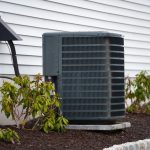Air conditioning is a fundamental aspect of contemporary building design, playing a vital role in ensuring comfort and productivity in diverse environments. The HVAC (Heating, Ventilation, and Air Conditioning) system, specifically the central cooling plant, assumes a critical role in providing conditioned air. This system comprises several essential components, with key players being the chiller, cooling tower, and air handling unit (AHU). In this article, we will explore the harmonious collaboration of these components in creating a comfortable indoor environment.
Chiller
At the core of the central cooling plant lies the chiller, responsible for producing chilled water, which is then used to cool the building’s air. Chilled water is essentially water cooled to a specific temperature. Depending on the type of chiller used, it can be situated either in the building’s basement or on the rooftop. Two primary chiller types are the air-cooled and water-cooled varieties.

- Air-cooled chillers: These units utilize fans to blow cool ambient air over their condenser, removing heat without the need for a cooling tower. However, for the purpose of this article, we will focus on water-cooled chillers and their interaction with cooling towers.
- Water-cooled chillers: Comprising an evaporator and a condenser, these chillers generate chilled water. The evaporator is where the chilled water is produced and typically leaves at around 6°C (42.8°F). A chilled water pump then circulates this water throughout the building via pipes known as “risers.”
Air Handling Unit (AHU)

The chiller distributes chilled water from the risers to various floors in the building. At each floor, the chilled water branches into smaller pipes that lead to the Air Handling Units (AHUs) and Fan Coil Units (FCUs). AHUs and FCUs are essentially boxes with fans that draw in air from the building, pass it over heating or cooling coils, and then return the conditioned air back into the building.
As the chilled water enters the AHU/FCU, it flows through a cooling coil, a series of thin pipes where it absorbs heat from the air passing over it. Consequently, the chilled water’s temperature increases, reaching around 12°C (53.6°F). The AHU/FCU then releases the cooled air back into the building, effectively regulating the indoor temperature.
Cooling Tower
As the chilled water absorbs heat from the building’s air in the AHUs/FCUs, it returns to the chiller through the return riser. Once it re-enters the chiller’s evaporator, the refrigerant absorbs the unwanted heat from the chilled water and transfers it to the condenser.
The condenser of the chiller collects the unwanted heat before sending it to the cooling towers. Here’s how the process works:
- Condenser Water: Another loop of water, called “condenser water,” flows through the chiller’s condenser in a closed-loop system. This water acts as a heat transfer medium, collecting the unwanted heat from the condenser’s refrigerant.
- Cooling Tower Operation: The condenser water, now carrying the collected heat, is pumped up to the cooling towers, typically located on the building’s rooftop. These towers are equipped with large fans that draw in ambient air.

Once the condenser water reaches the cooling tower, it is sprayed into the air stream. The cool ambient air comes into direct contact with the condenser water’s spray, facilitating heat transfer. Consequently, the heat from the condenser water is released into the atmosphere as the air blows it out. The condenser water then returns to the chiller’s condenser, ready to collect more heat.
In Conclusion
The chiller, cooling tower, and air handling unit work in seamless harmony to provide efficient air conditioning to a building. The chiller generates chilled water, which is distributed through the building to the AHUs and FCUs, where it cools the indoor air. As the chilled water absorbs heat from the building, it returns to the chiller’s condenser, and the unwanted heat is transferred to the condenser water. Finally, the cooling tower releases the collected heat into the atmosphere, and the condenser water returns to the chiller to repeat the cycle.
This intricate process ensures that the HVAC system maintains a comfortable indoor environment while efficiently managing and removing the unwanted heat from the building. Understanding how these components collaborate allows for better appreciation and management of the central cooling plant, ultimately contributing to the overall efficiency and functionality of the building’s air conditioning system.






GIPHY App Key not set. Please check settings